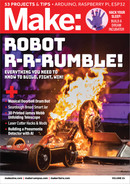
and connected his own E-Nose to my Azure
IoT platform. In real-time both of our E-Nose
frameworks started to report their readings:
they were both “smelling” ambient air and
indicated it corresponded to “Caleb’s room.”
This is incredibly important because this
means doctors could have the opportunity
of helping diagnose an ill patient who may
not have the means to get to a hospital or a
doctor’s office. Even better, regarding the Covid
pandemic, as new strains develop doctors can
diagnostically record data faster and identify
different variants more efficiently without
waiting for lab test results.
MOVING FORWARD
This March I entered my project in the 2022
Los Angeles County Science Fair. I took second
place! Next up, I will be competing nationally
later this spring, and will be registering for
international competitions too.
Granted, my E-Nose has a long way to go. This
was just my first prototype. Better calibration
and more-sensitive sensors will be needed —
specifically, sensors that can also differentiate
between the massive amount of volatile organic
compounds in human breath.
Nonetheless, it is a great starting point. By
joining highly sensitive sensors with AI and
tiny machine learning (tinyML) to detect breath
markers, in the very near future we may be able
to breathe into our phones and have doctors
diagnose our health issues remotely. I’m excited
about what the future may bring in medical
diagnostics.
A NOTE FROM BENJAMIN
I built the prototype of my infamous “artificial
nose” in just a couple hours (Make: Volume 77,
makezine.com/projects/second-sense-build-
an-ai-smart-nose). As a software engineer
and electronics enthusiast, I was convinced
that I hadn’t invented anything new. Surely,
“E-Nose” technology had to be available
already if I could pull this together using cheap
gas sensors and with zero machine-learning
knowledge. I could not have been more wrong!
In retrospect, I’m glad I took the time to
share this project with the world, as it has
inspired many folks. For example, I had
discussions with flavorists (yes, it’s a thing!)
who knew about smell sensors but hadn’t
realized what AI could bring to their field,
and also with AI experts who had no idea
about the landscape of available sensors. I
experienced first-hand how much bias there is
in the assumptions we tend to make about how
others perceive a particular technology area.
When Caleb Kodama contacted me last
year, I initially didn’t take the time to return
his emails (sorry, Caleb!). As you see from his
story, he’s not the kind of kid that takes silence
for an answer, so he wrote to me until I finally
replied. We eventually got on the phone, and
as I learned more about his project, I was
blown away by his creativity and what he had
accomplished. His project is to me the perfect
example of how the maker spirit — and open
source in general — truly democratizes access
to technology, and how it empowers anyone to
innovate. —Benjamin Cabé
Real-time readings from my and Benjamin Cabé’s E-Noses.
19
make.co
Heather Kodama (aka Mom)
M81_016-19_PneumoniaNose_F1.indd 19M81_016-19_PneumoniaNose_F1.indd 19 4/12/22 1:34 PM4/12/22 1:34 PM
..................Content has been hidden....................
You can't read the all page of ebook, please click here login for view all page.
